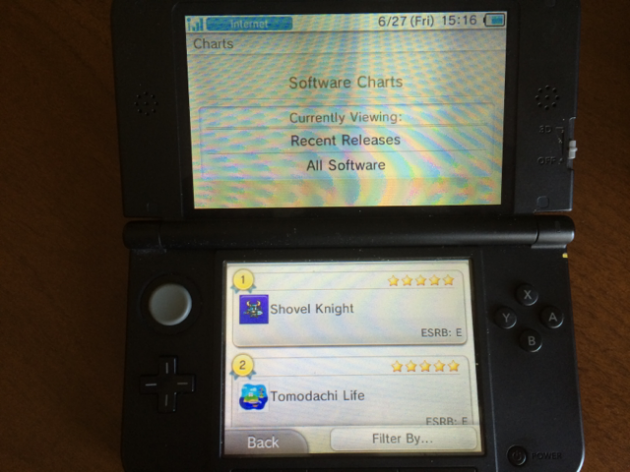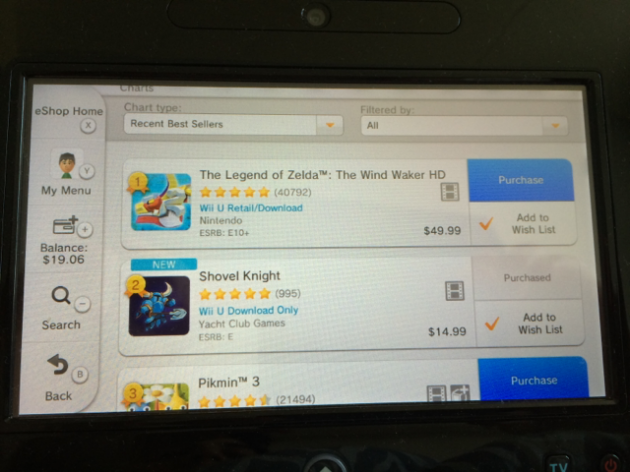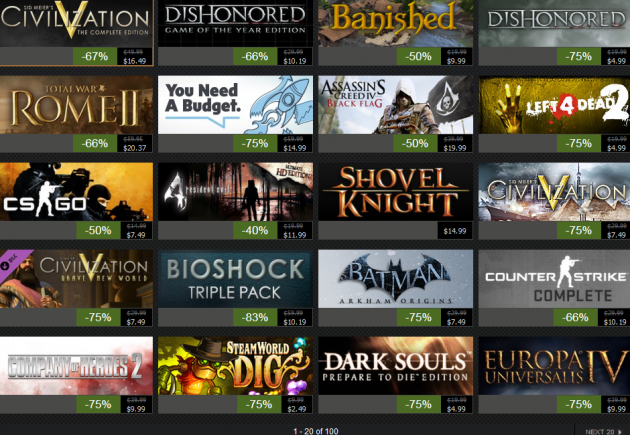So Shovel Knight has been on sale in the US on Wii U/3DS and internationally on Steam (only in English) for over a month now! Pretty nuts to see our little fledgling Kickstarter all grown up and in the wild. Believe it or not, besides the desire to make a great game, one of the reasons the team wanted to leave our safe and secure jobs behind and enter the indie world was to make the development process more accessible to the public – so that you all would have a better idea of how games are made and how to measure their success. That’s our task today!
Unfortunately, most developers aren’t permitted or aren’t willing to just give away sales expectations or results! Fortunately, we’re not like most developers. Hopefully we can add more pieces to the tiny pile of existing information to help out other developers, journalists, enthusiasts, and Grandma Swamp-a-likes for the future. You all are the reason this game even exists, and we feel it’s our responsibility to let you know about every detail that went into its construction. If you know of other developers that have done something similar, be sure to post it in the comments to help anyone who is on the lookout.
Alright, here we go! We’re going to be stepping through the whole process from dream to Kickstarter to release, sprinkling in our sales numbers and some statistics throughout about how our game has done from June 26th – July 26th. Keep in mind, none of the numbers we’ll share are precise as pinning down the numbers can be tricky for various reasons. We’ve given it our best shot!
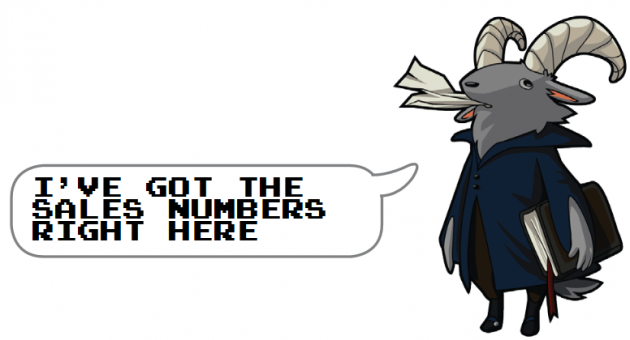
It all began with a Kickstart!
To know what our current sales numbers mean, you have to know where we started! On April 13th, 2013, we finished our Kickstarter campaign, funded by our lovely, amazing 14,749 backers for a grand total of $311,502. We also ran a concurrent Paypal donation period, where 935 backers reaching a total of $17,180 also joined in on the fun. When the campaign concluded, we asked all the backers to tell us what platform they wanted the game for….and here are the results!
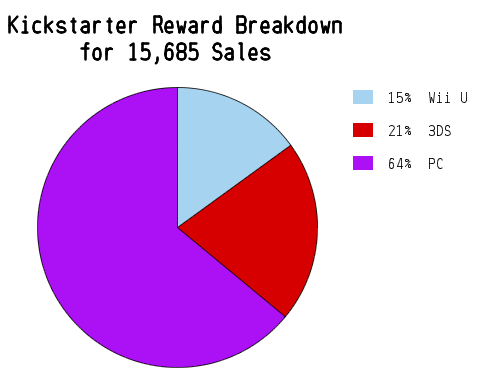
Surprisingly, Nintendo backers only provided around a third of the total support. We would have expected this number to be much higher given how focused (at least inwardly) our campaign was around Nintendo platforms. Were the naysayers right; do Nintendo indie games not sell well!? We’ll come back to this point later when we discuss the full sales, but it’s probably safe to say that early on, Kickstarter was still a PC dominated platform.
So in total, we went into full Shovel Knight production with $328,682 in hand for the rest of development (keep in mind, that 328k does not account for taxes, Kickstarter’s takeaway, fees, backers that dropped payment, etc). That certainly is a large sum by itself, but not quite so when it comes to making a game!
It may be surprising, but even a small downloadable game can often cost upwards of a million dollars to make! We planned a game that was going to take five people more than a full work week (six if you count Jake) for two years (this schedule includes a year for the game, with an additional year for developing stretch goal content)! That kind of game simply is not possible on 328k, and let’s break down why!
Cost of development
What does a game usually cost? How do you even figure that out? Well, it’s tough to be honest, but a very standard metric is to determine how many employees will be on the team, and multiply their cost by the amount of time the game is in development. This isn’t super accurate because in the game development world, we criminally underestimate each component’s time and effort. Typically we compensate for this by overestimating the time/salary/quantity elements out a bit.
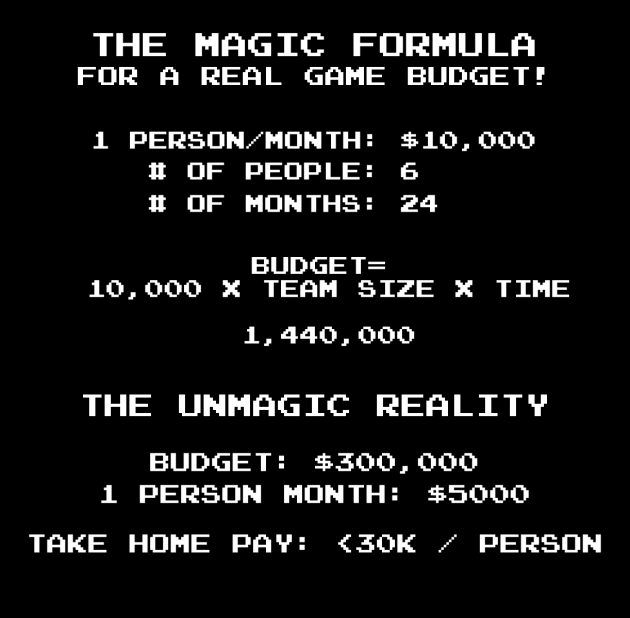
So let’s do that for Shovel Knight! These days, most studios will put the average cost of a developer on a game at around a $10k man month. What does that mean? Essentially, each developer will cost the company 10,000 dollars a month or 120,000 dollars a year. Now, of course, not every developer on the team makes that much money and often, NONE of the developers on the team make that much money.
That’s because this monthly $10k goes into much more than just paying the salary of the employee. It covers any and all expenses accumulated from having that employee on site. That includes not only individual expenses for the employee like salary, health insurance, etc but also company expenses like rent, electricity, water, food/snacks, conventions, computer and other equipment, software licenses, lawyer fees, taxes, development kit expenses…the list goes on and on. Given that it encompasses so much, we can use this figure to calculate the cost for the entire game. Also note that some developers may only be on a project for a few months, while others will work for the whole project’s duration. The man month total number can vary widely for games, but for Shovel Knight, we figured it was something around 144 man months to finish the game.
Now, YOU too have the power to estimate game budgets! Just multiply it out! For example, a 50 person team working for two years? That would be 12,000,000! Twelve million dollars! You can see how game budgets really start to add up!
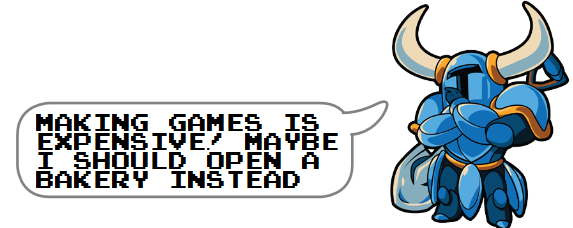
If you’re running the numbers in your head, you might be thinking – you told us you were going to make and release Shovel Knight and its stretch goals within 2 years! There are six people behind the core team that made Shovel Knight. According to the standard rules we just established, to make Shovel Knight in the two years we thought it would take, we would need $1,440,000 on hand!! Well that just wasn’t going to happen!
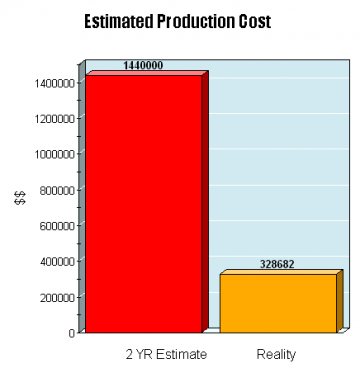
Why don't the graphs line up?! Welp, when you can't raise the budget, *CRACK* Redo the math!
So what did we do to offset that cost? First, we took Jake Kaufman’s salary out of the equation – he was generous enough to agree to a post-release payment and diligent enough to provide most of the sound and music in a very short time frame. With that cost mitigating measure, we’re now we’re down to $1,200,000…that didn’t help much!
Next we decided that, yes, this was a two year game to make including the stretch goals, but we could probably squeeze it into a year if we took those out and released them as free updates in the future using the sales of the game to fund the cost. In case you were wondering, that’s why we announced during the Kickstarter that the stretch goals would be post release content. We were planning that far in advance! Ok, so we get to cut the budget in half by shaving off a year: we’re down to $600k now. We’re getting close.
Unfortunately, we’ve now run out of options – the only thing left to do is cut the amount allocated for each person by half. So now we’re running on $5k man months – which is extremely low. At first, that sounds like $60k per year, but with the company costs, taxes, etc, in reality, it’s more like $30k for each of us over the course of the year… and that’s before any taxes.
At this point you have to be thinking, $30k minus taxes for one year’s salary, a grueling work pace (think: 12-18 hours a day, 7 days a week) and no stability whatsoever….why bother? An NES game, that’s not going to sell. The 80’s are over, man, get with the times! The cool kids are all into the AAA explosive action sequences. You’ll never make it!
Why bother?
Not a bad question honestly. Let’s add to the equation the fact that we knew that signing up for this project was much more than just developing Shovel Knight. Because we were solely in charge of handling the business, marketing, publishing, merchandise, support, and so on for the game, we were committing all our waking hours to the game. We knew we would finish Shovel Knight and barely keep our souls and lives intact. We would be sleeping and eating Shovel Knight and not remember what the sun looked like from our windowless office space. It would be gruelingly terrible. And there was no safety net.
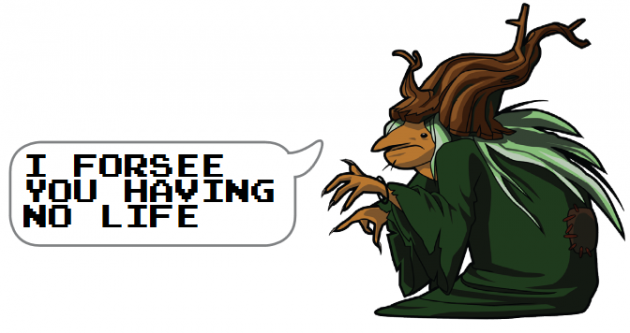
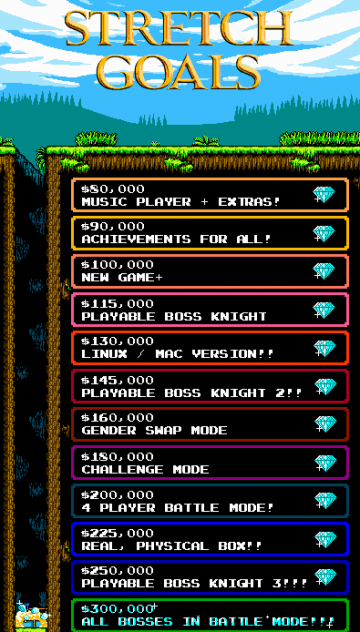
Uh oh! Did we Overpromise?!
Of course, the obvious reason for making Shovel Knight and going in with this doomed perspective was that we really wanted to make this game, and we believed in it! It was a passion project! Not only that, we met so many great people during the course of the Kickstarter campaign who believed in it too! The world needed Shovel Knight, we needed to develop it, and we didn’t care if we had to sacrifice ourselves to do it. We also wanted to control every part of the game, from marketing to development, and were not willing to relinquish any authority on the matter. This we think is obvious from our Kickstarter!
But what isn’t obvious is that we knew that Shovel Knight would be a success. We didn’t have a doubt in our mind because we had years of experience budgeting and developing games (and sacrificing ourselves…), and we had some concrete numbers to back us up. That’s why we felt confident planning so far ahead, and saying we would present the Kickstarter stretch goals as free updates in the future.
What concrete numbers do we speak of? We’re talking the 15,684 people that supported us during the Kickstarter campaign. Other developers have estimated that preorders predict first-week sales by 200-400%. That means Shovel Knight was guaranteed to sell 2-4 times the 15,684 backers in the first week, or in other words, 30k-60k copies in the first week. That of course seemed crazy to us…as successful games in our portfolio barely broke 50k copies sold. But we weren’t going to fight the numbers we arrived at. We felt a level of security, so we instead prepared ourselves for the brutal 12 months ahead.
This all goes to show that planning isn’t everything! We felt confident, but in the end we missed our target – remember how we didn’t release our game on March 31st? Yep, that was also the point that the budget was gone, and when our reserves ran low – also known as “we ran out of money” (actually it was March 1st).
We stopped any and all spending that wasn’t absolutely crucial to the game and the game’s Kickstarter. Having already budgeted out and frozen big amounts like Kickstarter reward costs, we were down to the day to day. Electricity? Needs to be on. Internet? Need that too. Dirt Letter Envelopes? Order ’em. Supporting ourselves? Well…
We ended up operating for five months without money or payments to the team here. It was a difficult period, where some of us were awkwardly standing in front of cashiers having our credit cards declined, drawing from any possible savings, and borrowing money from our friends and family. But we made it to the other side!
First month sales
Finally, we released the game on June 26th! And now, the moment everyone has been waiting for! How much did the game actually sell?! Let’s jump right into it! In the first week, if you take out our Kickstarter presales, we essentially sold 75,000 copies!!! Absolutely insane! It blew our 2x-4x pre-sale expectation out of the water!
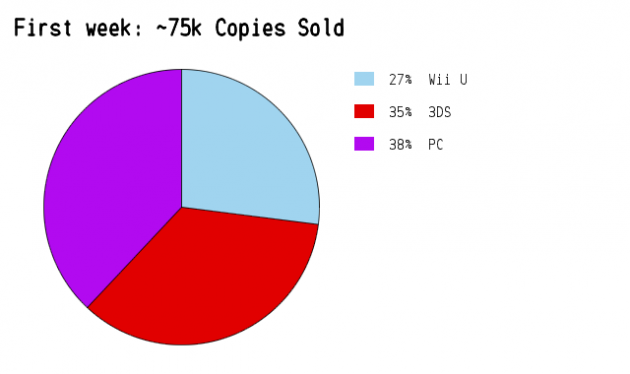
There are a few reasons we think our preorder prediction ended up being such a conservative estimate. One is…we were a Kickstarter! That’s not quite the same thing as a preorder. People could only attain the preorder for a limited time, so the stats aren’t 100% aligned with what a preorder would do. We think due to the PC nature of Kickstarter, we saw a higher amount of sales on Nintendo’s platform when the game actually got released. Nintendo users are more inclined to buy the game day one rather than through a preorder on Kickstarter. Finally, the preorder prediction isn’t a set in stone statistic, but more like a guideline for what to expect. We had done a lot of promotion and marketing at conventions and on media sites to prove ourselves over the course of the year, and we think people responded to it in kind! Nintendo also did an amazing job supporting us through their store placement and own marketing channels.
Not only did we outsell our expectations, but we also made it to the top of all of the charts! While we did everything we could to spread the word, this could not have happened without everyone’s enthusiasm out there. Each and every positive impression, playthrough video, stream, tweet, fan art, recommendation, critical comment, email, vote, and review made this possible! As you can see above, Shovel Knight hit the number one spot on the 3DS, the number 2 spot on the Wii U, and although the picture doesn’t show this (we couldn’t find one we captured for proof), we were among the top 10 games on Steam. Did we mention that we were complete buffoons and, against all of Valve’s advice, we launched Shovel Knight during the Steam Summer Sale when we had major bargains as competition?! Yeah, we’re crazy, but we still managed to crack the top 10! We don’t know guys…SteamWorld Dig sure sounds more appealing at two bucks. Also, while we hit 2nd on the Wii U store, it should be noted we were competing with a bunch of free games that were being given away as part of the Mario Kart 8 promotion. I wouldn’t expect us to beat a game that sold more than 2 million copies, where each person got to choose a free game on the eShop! So we’re pretty proud we even came close to Wind Waker!
So that’s a great first week, but of course, sales commonly take a quick dive after launch, so where are we sitting after a month? Here are the current totals up to July 26th:
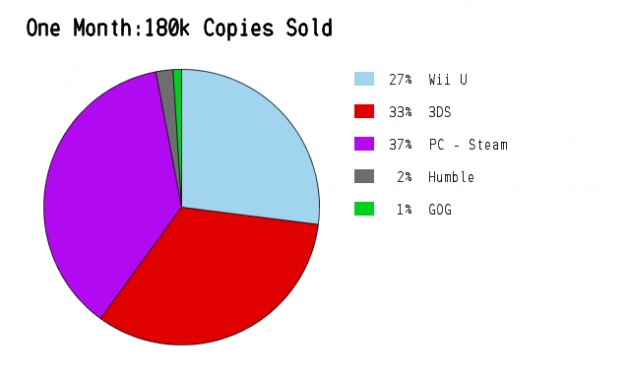
Note: this includes review copies and Kickstarter copies
Overall, we’re extremely happy with the sales! We don’t have sales data on many other digital games to offer a comparison, but we do know it’s doing very well for our company – meaning the six of us! This means we can keep our current course and continue making the stretch goal content without fear of disbanding or seeking additional funding. It means we can continue living our dreams producing awesome games for our incredible fans (and soon-to-be fans)! And we still have lots of markets to release the game in – Australia, Europe, Japan…although those markets are typically less when compared to America, they will definitely help contribute to our next efforts. The steady supply of free stretch goal content updates should also provide a nice boost in sales once each is released.
Thank You!!!
After the Kickstarter project ended, we all discussed our sales goals. The number that most of us settled upon was….when all was said and done, 150,000 copies sold in total. That was our high point! So thank you, everyone, who supported us and made it possible for Shovel Knight to surpass that in just the first month. We are blown away!
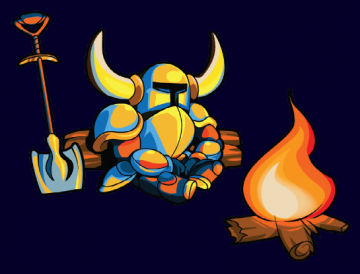
It’s been a crazy ride! We’re not done yet though. We’re going to keep working our hardest to keep this game loved, played, and selling like hotcakes. Our new goal is the quest to 1 million sold, to truly solidify Shovel Knight as a modern platinum classic! For all of you who had doubts that a Wii U game or a digital game on a Nintendo platform could sell, we hope these facts show that a good game on any system, marketed the right way, can sell.
Thank you everyone for your support!!!
That’s not all! Join us Thursday, and we’ll break down these stats a little more: How has the Steam version been selling by region, how many people beat the game, how much gold has been collected, and much more will all be tackled. And if you have any questions about the numbers or anything listed here, we’ll be sure to answer them in the next post! So stay tuned!

